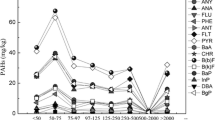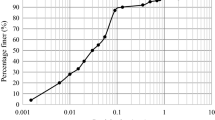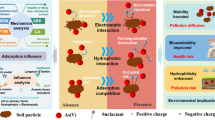Abstract
Purpose
With the increase of surfactant usages, more and more concerns were paid on their effects on the physicochemical characteristics of soils. Up to now, only few researches have examined the effects of ionic surfactants on the stability of soil structure and soil water repellency.
Materials and methods
Cetyltrimethyl ammonium bromide (CTAB) as cationic surfactant and sodium dodecyl sulfate (SDS) as anionic surfactant were adopted to investigate their effects on the aggregate stability and water repellency of a silt loam soil which was sampled in Corn High-Tech Park, Huang-Huai-Hai region, China. (1) Aggregate stability: 50 g soil was mixture with 100 mL surfactant solution in a beaker. The concentrations of surfactant solutions were 0 (the blank), 200, 400, 600, 800, 1000, and 2000 mg L−1, respectively. After 30 min, the soil was sieved and divided into four fraction aggregates. (2) Soil water repellency: the concentrations of surfactant solutions were the same as experiment 1. Forty grams of soil was blended with 80 mL surfactant solution in an aluminum specimen. Drying the water by oven of 40 °C firstly and then by air, the whole period was about 1 week. After that, soil water infiltration and sorptivity were measured.
Results and discussion
Compared to the blank, surfactants increased the amounts of 2–0.25 and <0.053 mm aggregates of the soil and decreased the amounts of 0.25–0.053 mm aggregates of the soil. Surfactants also increased the mean weight diameter (MWD) of the soil. Except the 200 mg L−1 treatment, CTAB promoted the soil water infiltration. All SDS treatments impeded the soil water infiltration. The soil repellency factor (R) value of the blank was 1.22, lower than the critical value of 1.95, which implied that the soil of blank treatment was free of soil water repellency. For CTAB, only 200 and 400 mg L−1 treatment’s R were higher than 1.95 while for SDS, all the treatment’s R were higher than 1.95.
Conclusions
Surfactants improved the stability of soil aggregates. Soil treated with CTAB did not show the repellency, whereas SDS treatment resulted in intense water repellency compared with the wettable blank soil. Findings of this study can be used to explain the role of ionic surfactants on soil structure stability as well as on the development of water repellency in lower soil depths.






Similar content being viewed by others
References
Al-Hadabi BA, Aoudia M (2014) Surfactant–surfactant and surfactant–solute interactions in SLES–Brij35 mixed micelles: effect of the degree of ethoxylation on pyrene solubilization enhancement in water. Colloid Surface A 459:82–89
Almendros G, Martin F, González FJ (1988) Effects of fire on humic and lipid fractions in a dystric xerochrept in Spain. Geoderma 42:115–127
Arriaga FJ, Lowery B, Kelling KA (2009) Surfactant impact on nitrogen utilization and leaching in potatoes. Am J Potato Res 86:383–390
Bauters TWJ, Steenhuis TS, Dicarlo DA, Nieber JL, Dekker LW, Ritsema CJ, Parlange JY, Haverkamp R (2000) Physics of water repellent soils. J Hydrol 231-232:233–243
Boulakradeche MO, Akretche DE, Cameselle C, Hamidi N (2015) Enhanced electrokinetic remediation of hydrophobic organics contaminated soils by the combination of non-ionic and ionic surfactants. Electrochimi Acta 174:1057–1066
Brady NC, Weil RR (2002) The nature and properties of soils, 13th edn. Pearson Prentice Hall, New jersey
Bughici T, Wallach R (2016) Formation of soil–water repellency in olive orchards and its influence on infiltration pattern. Geoderma 262:1–11
Cisar JL, Williams KE, Vivas HE, Haydu JJ (2000) The occurrence and alleviation by surfactants of soil-water repellency on sand-based turfgrass systems. J Hydrol 231-232:352–358
Culligan PJ, Ivanov V, Germaine JT (2005) Sorptivity and liquid infiltration into dry soil. Adv Water Res 28:1010–1020
Dekker LW, Ritsema CJ (2000) Wetting patterns and moisture variability in water repellent Dutch soils. J Hydrol 231-232:148–164
Doerr DH, Shakesby RA, Walsh RPD (2000) Soil water repellency its causes, characteristics and hyddro-geomorphological significance. Earth-Sci Rev 51:33–65
Dong GJ, Su Y, Wang GX (2009) Chemistry of surfactants, 1st edn. Beijing institute of technology press, Beijing (in Chinese)
Gardner KH, Arias MS (2000) Clay swelling and formation permeability reductions induced by a nonionic surfactant. Environ Sci Technol 34:160–166
Haigh SD (2004) A review of the interaction of surfactants with organic contaminants in soil. Sci Total Environ 70:4855–4863
Hallett PD, Young IM (1999) Changes to water repellence of soil aggregates caused by substrate-induced microbial activity. Eur J Soil Sci 50:35–40
Harendra S, Vipulanandan C (2013) Sorption and transport studies of cetyl trimethylammonium bromide (CTAB) and Triton X-100 in clayey soil. J Environ Sci 25:576–584
Jury WA, Gardner WR, Gardner WH (1991) Soil physics, 5th edn. John Wiley and Sons, New York
Kamil M, Siddiqui H (2013) Experimental study of surface and solution properties of gemini -conventional surfactant mixtures on solubilization of polycyclic aromatic hydrocarbon. Model Numer Simul Mater Sci 03:17–25
Kostka SJ (2000) Amelioration of water repellency in highly managed soils and the enhancement of turfgrass performance through the systematic application of surfactants. J Hydrol 231-232:359–368
Leeds-Harrison PB, Young EG, Uddin B (1994) A device for determining the sorptivity of soil aggregates. Eur J Soil Sci 45:269–272
Lehrsch GA (2013) Surfactant effects on the water-stable aggregation of wettable soils from the continental USA. Hydrol Process 27:1739–1750
Lehrsch GA, Sojka RE (2011) Water quality and surfactant effects on the water repellency of a sandy soil. J Hydrol 403:58–65
Lehrsch GA, Sojka RE, Reed JL, Henderson RA, Kostka SJ (2011) Surfactant and irrigation effects on wettable soils: runoff, erosion, and water retention responses. Hydrol Process 25:766–777
Lehrsch GA, Sojka RE, Koehn AC (2012) Surfactant effects on soil aggregate tensile strength. Geoderma 189-190:199–206
Letey J, Carrillo MLK, Pang XP (2000) Approaches to characterize the degree of water repellency. J Hydrol 231-232:61–65
Li CL, Xu JB, He YQ, Liu YL, Fan JB (2012) Dynamic relationship between biologically active soil organic carbon and aggregate stability in long-term organically fertilized soils. Pedosphere 22:616–622
Lu RK (1999) Analytical methods of soil agrochemistry, 1st edn. China agricultural science and technology press, Beijing (in Chinese)
Mats A (2000) Mixed micelles and other structures in the solubilization of bilayer lipid. BBA-biomenbranes 1508:146–163
Mbagwu JSC, Piccolo A, Mbila MO (1993) Impact of surfactants on aggregate and colloidal stability of two tropical soils. Soil Tech 6:203–213
Mingorance MD, Gálvez JF, Peña A, Barahona E (2007) Laboratory methodology to approach soil water transport in the presence of surfactants. Colloid Surface A 306:75–82
Mulligan CN, Yong RN, Gibbs BF (2001) Surfactant-enhanced remediation of contaminated soil—a review. Eng Geol 60:371–380
Piccolo A, Mnagwu JSC (1989) Effect of humic substances and surfactants on the stability of soil aggregates. Soil Sci 147:47–54
Rodriguez-Cruz MS, Sanchez-Martin MJ, Sanchez-Camazano M (2005) A comparative study of adsorption of an anionic and a non-ionic surfactant by soils based on physicochemical and mineralogical properties of soils. Chemosphere 61:56–64
Sales PS, de Rossi RH, Fernandez MA (2011) Different behaviours in the solubilization of polycyclic aromatic hydrocarbons in water induced by mixed surfactant solutions. Chemosphere 84:1700–1707
Shin KH, Kim KW, Ahn Y (2006) Use of biosurfactant to remediate phenanthrene-contaminated soil by the combined solubilization-biodegradation process. J Harzard Mater 137:1831–1837
Six J, Bossuyt H, Degryze S, Denef K (2004) A history of research on the link between (micro)aggregates, soil biota, and soil organic matter dynamics. Soil Till Res 79:7–31
Tehrani-Bagha AR, Singh RG, Holmberg K (2012) Solubilization of two organic dyes by cationic ester-containing gemini surfactants. J Colloid Interf Sci 376:112–118
Tillman RW, Scotter DR, Wallis MG (1989) Water-repellency and its measurement by using intrinsic sorptivity. Aust J Soil Res 27:637–644
Tisdall JM, Oades JM (1982) Organic matter and water-stable aggregates in soils. Soil Sci 33:141–163
Tsakiroglou CD, Aggelopoulos CA, Tzovolou DN, Theodoropoulou MA, Avraan DG (2013) Dynamics of surfactant-enhanced oil mobilization and solubilization in porous media: experiments and numerical modeling. Int J Multiphase Flow 55:11–23
Wang Z, Wu QJ, Wu L, Ritsema CJ, Dekker LW, Feyen J (2000) Effects of soil water repellency on infiltration rate and flow instability. J Hydrol 231-232:265–276
Wiel-Shafran A, Ronen Z, Weisbrod N, Adar E, Gross A (2006) Potential changes in soil properties following irrigation with surfactant-rich greywater. Ecol Eng 26:348–354
Xu S, Boyd SA (1995) Cationic surfactant sorption to a vermiculitic subsoil via hydrophobic bonding. Environ Sci Technol 29:312–320
Ying GG (2006) Fate, behavior and effects of surfactants and their degradation products in the environment. Environ Int 32:417–431
Acknowledgements
This research was financially supported by Specialized Research Fund for the Doctoral Program of Higher Education (2012370212003), Ministry of Education, China, and 54th China Postdoctoral Science Foundation Projects (2013M540562).
Author information
Authors and Affiliations
Corresponding author
Additional information
Responsible editor: Rainer Horn
Rights and permissions
About this article
Cite this article
Qi, X., Liu, Y., Zhang, M. et al. Effects of ionic surfactants on the aggregate stability and water repellency of silt loam soil. J Soils Sediments 17, 2438–2448 (2017). https://doi.org/10.1007/s11368-017-1686-4
Received:
Accepted:
Published:
Issue Date:
DOI: https://doi.org/10.1007/s11368-017-1686-4




